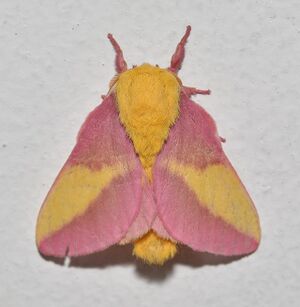Dryocampa rubicunda: Difference between revisions
No edit summary |
No edit summary |
||
| Line 16: | Line 16: | ||
| '''Order:''' Lepidoptera | | '''Order:''' Lepidoptera | ||
|- | |- | ||
| '''Family:''' | | '''Family:''' Saturnidae | ||
|- | |- | ||
| '''Genus:''' Dryocampa | | '''Genus:''' Dryocampa | ||
| Line 24: | Line 24: | ||
==Description== | ==Description== | ||
The colors of the rosy maple moth make it easy to spot. Bright pink and yellow is the most common color combination, but the colors can also vary from light purple, cream or white. The rosy maple moth is the smallest of the silk moths [4]. The average wingspan for both males and females is 32 to 55mm. Males have narrower wings with less rounded hindwings and have more ornamental bipectinate antennae [3]. | The colors of the rosy maple moth make it easy to spot. Bright pink and yellow is the most common color combination, but the colors can also vary from light purple, cream or white. The rosy maple moth is the smallest of the silk moths [4]. The average wingspan for both males and females is 32 to 55mm. Males have narrower wings with less rounded hindwings and have more ornamental bipectinate antennae. | ||
Known as green-striped mapleworms, the caterpillars of the rosy maple moth vary in color depending on age. Young larvae are yellow/cream in color with faint longitudinal green stripes and black heads. Once the caterpillar is fully grown it has a yellow/green body with seven dark green lines and a red/brown head [3]. | |||
==Growth and Reproduction== | ==Growth and Reproduction== | ||
Rosy maple moths are solitary creatures, unless mating. During early summer, when a female is ready to mate she gives off a pheromone that is detected by the males from up to a half mile away [2]. The female lays her eggs on the underside of tree leaves [4]. The eggs are a pale yellow color laid in clusters of 20 to 30 [1]. Once they feed and mature, the larvae will crawl down the tree to find a place to burrow and form a pupa, where it spends most of its life [4]. Like other members of the silk moth (Saturnidae) family, the caterpillars form a silk cocoon [2]. | |||
==Habitat and Range== | ==Habitat and Range== | ||
Revision as of 18:41, 9 May 2022
Dryocampa rubicunda, more commonly known as the rosy maple moth, is a small silk moth in the Saturniidae family. Identified by its bright pink and yellow coloring, the rosy maple moth can be found near its host trees throughout North America.
 |
| Scientific Classification |
|---|
| Kingdom: Animalia |
| Phylum: Anthropoda |
| Class: Insecta |
| Order: Lepidoptera |
| Family: Saturnidae |
| Genus: Dryocampa |
| Species: D. rubicunda [1] |
Description
The colors of the rosy maple moth make it easy to spot. Bright pink and yellow is the most common color combination, but the colors can also vary from light purple, cream or white. The rosy maple moth is the smallest of the silk moths [4]. The average wingspan for both males and females is 32 to 55mm. Males have narrower wings with less rounded hindwings and have more ornamental bipectinate antennae. Known as green-striped mapleworms, the caterpillars of the rosy maple moth vary in color depending on age. Young larvae are yellow/cream in color with faint longitudinal green stripes and black heads. Once the caterpillar is fully grown it has a yellow/green body with seven dark green lines and a red/brown head [3].
Growth and Reproduction
Rosy maple moths are solitary creatures, unless mating. During early summer, when a female is ready to mate she gives off a pheromone that is detected by the males from up to a half mile away [2]. The female lays her eggs on the underside of tree leaves [4]. The eggs are a pale yellow color laid in clusters of 20 to 30 [1]. Once they feed and mature, the larvae will crawl down the tree to find a place to burrow and form a pupa, where it spends most of its life [4]. Like other members of the silk moth (Saturnidae) family, the caterpillars form a silk cocoon [2].
Habitat and Range
The rosy maple moth is native to North America. Their range extends from southern Canada down the eastern coast to Florida and as far west as Michigan down to Texas. As its name would suggest, this moth prefers a variety of maple trees (sugar maple, red maple, silver maple and box elder maple) and turkey oak trees. It can be found in suburban areas where its host trees exist [3].
Ecological Signifigance
References
[1] "Rosy Maple Moth (Dryocampa rubicunda) - Jungle Dragon." https://www.jungledragon.com/specie/1395/rosy_maple_moth.html
[2] "Rosy Maple Moth (Dryocampa rubicunda)." https://www.insectidentification.org/insect-description.php?identification=Rosy-Maple-Moth
[3] "Dryocampa rubicunda (rosy maple moth)." https://animaldiversity.org/accounts/Dryocampa_rubicunda/
[4] "Rosy Maple Moth (Dryocampa rubicnda)." https://hgic.clemson.edu/factsheet/rosy-maple-moth-dryocampa-rubicunda/
[5] "Rosy Maple Moth Facts." https://factanimal.com/rosy-maple-moth/